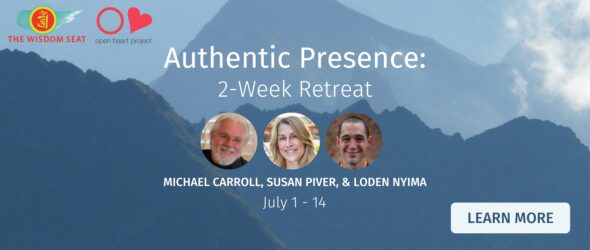Strong Emotions and Meditation Practice
By Susan Piver
A misconception about meditation practice
One of the very big misconceptions about meditation practice is that it will help you not to feel things too strongly—except for maybe peace, goodwill, and bliss (whatever that means). Eventually perhaps this will become true, but for most of us, when strong feelings—especially strong negative feelings—are encountered, we view this as a failure of our practice. Like, if I was better at meditation, I could avoid becoming enraged when called an asshole by another driver (who was the asshole in this case, let’s face it) or the fact that my neighbor’s dog poops on my lawn every single day. I could avoid sorrow when my love is unrequited or I find that a dear friend is ill. I could avoid anxiety when I have to find a new job or have a scary appointment with the doctor.
In the sort of spiritually materialistic world we live in, we could find many suggestions for how to achieve such a state of implacability. Some of them are about avoiding dangerous situations (physical, emotional, spiritual) altogether by just staying home. Some direct you to assert yourself in the face of difficulty by taking strong action, fighting back. Some revolve around restructuring the way your mind works so that you only think the thoughts that make you happy and are thus able to “attract” good things—or, when bad things happen, you replace your sad and weary thoughts with perkier, brighter ones.
There is nothing wrong with making efforts along these lines. It is vitally important that we take precautions against danger by safeguarding ourselves on all levels. We should react boldly when it is called for. And of course we should examine our thoughts for self-sabotage and try to craft an inner environment of joy and positivity.
However. If we do so with the intention of creating a life where anger, sorrow, and fear have no place, then I’m afraid we will be quite disappointed.
Turning toward emotions
My dear friends. Please know that I wish for you only peace, joy, and love. But it is impossible to avoid the sorrows of being human and actually, if it were, we would cease to be human. At the core of anger is great vitality. At the heart of sorrow is love. Underneath fear is sadness, which is soft and workable. When you turn toward anger, sorrow, and fear, in some way you are gaining access to vitality, love, and great tenderness. You can’t separate them.
It would be a very small being indeed who could tolerate only the so-called positive feelings. You are capable of a vast range of emotion and connecting with this storehouse also connects you to poetry, passion, and your own brand of utter brilliance. We have a choice: feel it all or go home.
Learning to ride the waves
So it behooves us greatly to learn to meet our difficult emotions and our meditation practice can help in two ways:
First, by teaching you how to sit (literally) with yourself as you think, feel, and experience whatever arises, always returning to breath, you learn to ride the waves of grasping, aggression, and avoidance with equanimity—not by ignoring them, but by allowing them to be exactly as they are. You are bigger than any particular feeling state and their is nothing you cannot contain.
Second, your meditation practice gives you a tool for encountering the strong emotions that you simply cannot let go of, no way, no how. Sometimes it happens during practice that deep, deep emotions arise and it is not possible (or advisable) to “just let them go.” In this case, your can slightly alter the meditation technique for as long as you need to. Rather than making your breath the object of awareness (as it is in classical shamatha practice), you could make your emotion the object of awareness. Not the story of the emotion (I feel this way because…. I wouldn’t feel this way if… I could stop feeling this if only…) but the feeling of the feeling: the heat or chill or constriction or weight of it. Make that the object of awareness and, when it strays, which it will, just as in normal shamatha practice, bring it back. Place your attention on your feeling over and over until it begins to dissolve—and then come back to breath.
Being unafraid
In this way, as meditators, we are learning to create a world for ourselves where we are unafraid of anger. Unafraid of sadness. Unafraid of fear. It’s not that we don’t feel such things, but they do not knock us down. This is a far more expansive, joyful, and humane way to live. And, as Tibetan meditation master Chogyam Trungpa writes in Shambhala: The Sacred Path of the Warrior, “The key to warriorship is not being afraid of who you are. Ultimately, that is the definition of bravery.”
Join Susan at DMC this summer!
About Susan Piver

Susan has been a practicing Buddhist since 1993 and graduated from a Buddhist seminary in 2004. She is an internationally acclaimed meditation teacher, known for her ability to translate ancient practices into modern life. Her work has been featured on the Oprah show, TODAY, CNN, and in the New York Times, Wall Street Journal and others. In 2013, she launched the Open Heart Project, the largest virtual mindfulness community in the world with 20,000 members.


